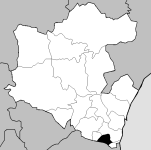Portela (Loures)
| Portela | ||
| Portela de Loures | ||
| Civil Parish (Freguesia) | ||
|
Commercial centre in the heart of the civil parish of Portela
|
||
|
||
| Official name: Freguesia de Portela | ||
| Name origin: Portuguese word for place where a road bends | ||
| Country | ||
|---|---|---|
| Region | Lisboa | |
| Subregion | Greater Lisbon | |
| District | Lisbon | |
| Municipality | Loures | |
| Center | Portela | |
| - elevation | 54 m (177 ft) | |
| - coordinates | 38°47′5″N 9°6′49″W / 38.78472°N 9.11361°WCoordinates: 38°47′5″N 9°6′49″W / 38.78472°N 9.11361°W | |
| Area | 0.95 km2 (0 sq mi) | |
| Population | 11,809 (2011) | |
| Density | 12,431/km2 (32,196/sq mi) | |
| Timezone | WET (UTC0) | |
| - summer (DST) | WEST (UTC+1) | |
| ISO 3166-2 code | PT- | |
| Postal Zone | 2686-601 Portela | |
| Area Code & Prefix | (+351) 219 XXX-XXXX | |
| Demonym | Portelense | |
| Patron Saint | Cristo-Rei | |
|
Location of the parish seat of Portela in the municipality of Loures
|
||
| Statistics: Instituto Nacional de Estatística | ||
| Website: http://www.jf-portela.pt | ||
| Geographic detail from CAOP (2010) produced by Instituto Geográfico Português (IGP) | ||
Portela (Portuguese pronunciation: [puɾˈtɛlɐ]) is a former civil parish in the municipality of Loures, Lisbon District, Portugal. In 2013, the parish merged into the new parish Moscavide e Portela.
In toponymic terms, Portela gets its name from two Portuguese definitions: portela is derived from a corruption of the Latin portulla or portella, which means small door or entryway, since it can be considered the accessway to Lisbon (and/or south part of the Tagus estuary); the term portela is also, literally a point where a road or street forms a bend or angle, ordinarily in a bottleneck or tributary. Geographically, the second statement is also true, since the parish's northern limits are cornered by two important bends (Avenida Infante Dom Henriques-IC17 and IC17-A1).
Portela's masterplan was deeply inspired by Swiss architect Le Corbusier's utopian scheme of "A Contemporary City for 3 Million People" (1922), and its urbanism based on the premise of a modern architecture that was exposed it to the maximum levels of sun, air and nature (as stated in the 1933 Athens Charter of Congrès International d'Architecture Moderne).
Similarly, in the early part of the 1960s, a development in Buenos Aires had a comparable affect on the future urbanization of Portela; the development was geometric in design, with composite linear roadways around a central centre. In Lisbon, a similar layout was achieved by a New York architect, who was commissioned to construct a development that centred on a large commercial mall in the 1970s (the first of its type to be completed using urban planning concepts in the capital). The idea was to organize apartment blocks around a central commercial structure, in order to create a pole of socio-economic activities. Constituted in 1985, the civil parish of Portela has become a Portuguese reference for urban architecture.
...
Wikipedia



